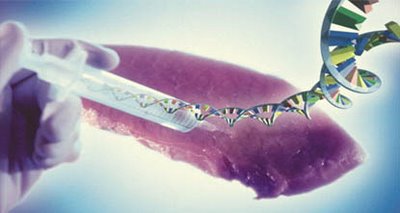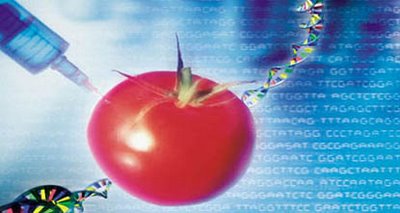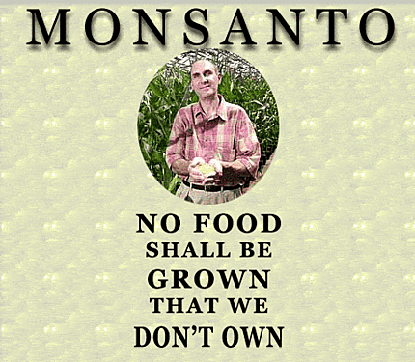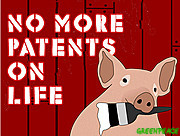Can GM food make your body immune to ANTIBIOTICS?

by Sean Poulter, Consumer Affairs Correspondent - Daily Mail, UK
Wednesday, July 17 2002
Our food is being genetically modified. The question again is why? What's wrong with it? Have not our food on this planet been sufficient for us so far? Why does it need to be changed, and who is changing it? Can modified food modify us? The food can work as an agent to get inside our body and then be designed to change the DNA of those who consume it. Can it change other parts of us also?
EATING GM food can change the genetic make-up of your digestive system and
could put you at risk of infections that are resistant to antibiotics,
experts said today.
A British study has revealed that volunteers who ate one meal containing
genetically modified soya had traces of the modified DNA in bacteria in
their small intestines.
Scientists now fear that GM foods, which are often modified to be resistant
to antibiotics, will leave Britons vulnerable to untreatable diseases. The
research contradicts repeated claims by the GM industry that gene transfer
from foods to humans is extremely unlikely. It also raises the possibility
that millions of people may already have GM bacteria from food they have
eaten.
The study, carried out at the University of Newcastle, consisted of feeding
seven volunteers GM soya. Researchers found that three of them had evidence
of DNA gene transfer in the bacteria that occurs naturally in their
digestive systems. This is the first time this transfer has been identified
in humans.
'THE STUDY RAISES SERIOUS CONCERNS'
Research leader Professor Harry Gilbert played down the dangers, but
confirmed that 'surprising' levels of GM DNA transfer were found. He said:
"There is some evidence of gene transfer, but it is at an extremely low rate
and therefore it probably does not represent a significant risk to human
health'. The research report suggested that this transfer may have
'reflected previous exposure of the subjects to genetically modified
plants'. But yesterday experts claimed the possibility of eating GM crops
containing antibiotic resistance genes raised 'serious concerns'.
Geneticist Dr Michael Antoniou, of Guy's Hospital, London, said the results
indicated the need for an extensive GM foods testing programme. He added:
"The most significant finding is that there is GM soya DNA in the bacteria
at readily detectable levels in the small intestines. 'It was always said
by the industry that this could not happen or was extremely unlikely. There
is a whole slew of different antibiotic resistant genes that are being used
in GM crops in their production in the laboratory. They stay in the final
crop.' These genes are often used as a marker to signal that the desired GM
change, such as resistance to a particular weed killer, has taken place.
Dr Antoniou added: 'Bacteria in the gut are going to take up genes that will
make them resistant to potentially therapeutic antibiotics. 'The possibility
is that someone who picked up the antibiotic resistance through food and
then fell ill, that a medical antibiotic might not be effective.'
However the Food Standards Agency tried to reassure consumers that GM foods
are safe. A spokesman said the findings had been assessed by several
Government experts who had ruled that humans were not at risk. In a
statement on its website, the agency said the study had concluded it is
'extremely unlikely' that GM genes can end up in the gut of people who eat
them.
Friends of the Earth GM expert Adrian Bebb said this response contradicted
the opinions of many international scientists. He added: 'The FSA's
attitude to the release of this information has been extraordinary. 'It can
only fuel concerns that the Government and its agencies only want the public
to hear positive news about GM. This is the first time a change to bacteria
in the gut has been identified in humans. It is enormously significant.
This is something the GM industry said could not happen. Yet in the first
experiment looking at just seven people, there it is. The suggestion that
the GM DNA could already have been in the bodies of the participants raises
important questions. Either it got into the gut many years ago and has been
passed down or people are eating GM soya in their diet on a daily basis.
Whatever the reason, it would seem millions of people could have GM DNA from
this soya in their bodies'.
PageTOP ^
Disclaimer
What are Genetically Modified or GM Foods?

Genetically modified foods (GM foods) have ingredients in them that have been
modified by a technique called gene technology.
This technology allows food producers to alter certain characteristics of a food
crop by introducing genetic material and proteins from another source.
WHAT IS GENETIC ENGINEERING?
The process of genetic engineering is known by many different names such as gene,
or DNA manipulation, gene splicing, transgenics and many others. However the
underlying processes all have the same aim and that is:
"To isolate single genes of a known function from one organism and transfer a copy
of that gene to a new host to introduce a desirable characteristic"
The structure of every living thing is determined by its genes. A gene is a
chemical code which contains an instruction for the body to express a particular
attribute such as eye colour, skin pigment or height. Each gene is made up of a
segment of DNA (deoxyribonucleic acid).
Scientists are able to extract DNA from any organism and can then isolate a
specific gene through the use of restriction endonucleases, which cut DNA strands at
specific points. The gene is then copied billions fold in readiness for transfer to
another organism.
NB: Many good illustrations and a full explanation of this and methods of genetic
engineering can be found in the reference "Gene Technology" by Sue Jarvis and John
Hickford.
METHODS OF GENE TRANSFER
There are four primary methods of introducing an isolated gene into the host.
These are:
-
Injection.
This is used primarily in animals. The new DNA is injected with a very small
sharp needle into the nucleus of a single cell. This cell is usually a fertilised
egg which can then be placed back in the female uterus where the injected cell is
allowed to develop normally.
Unfortunately there is a high rate of failure when using this technique as
cells infrequently take up and express the desired traits of the introduced
DNA.
-
Biolistics.
Biolistics is used in the genetic modification of plants and involves shooting
new genes into the potential host. Microscopic particles of gold or titanium are
coated in the DNA sections which are to be introduced to the host. These are
loaded into cartridges, similar to shotgun cartridges, which are then fired at
the plant cells. The process relies on some of the microscopic particles entering
this cell nuclei and their DNA coating combining with the plant chromosomes.
-
Vectors.
This method has the potential to be used in both plant and animal situations.
It involves a bacteria or virus carrying a new gene into a cell. Using a
modification of what is already happening in nature.
Example:
Common vectors in gene transfer between plants are Agrobacterium
tumefaciens and Agrobacterium rhizogenes. These bacteria are usually
found in the soil and if they infect plants will respectively cause galls or
hairy roots through introducing some of their own DNA into the plant. The
Agrobacterium transfer the DNA as a plasmid, a small circular piece of DNA, which
is separate to the main bacterial chromosome. Genetic engineering makes use of
this natural transfer of DNA through replacing a section of the bacteria’s
own DNA with a gene which scientists would like to introduce to a new host.
-
Protoplast transformation.
This is also commonly used in plants. The cellulose in the plant wall is
dissolved away using enzymes leaving a protoplast. DNA can then be added to the
protoplast which are then cultured on a growth media. This encourages the
protoplast to regrow cell walls and eventually grow into a transgenic plant.
PageTOP ^
Disclaimer
Most Offspring Died When Mother Rats Ate GM Soy
By Jeffrey M. Smith | GMWatch.com
2005 11 01
Jeffrey M. Smith is the Author of Seeds of Deception
 The Russian scientist planned a simple experiment to
see if eating genetically modified (GM) soy might influence offspring. What
she got, however, was an astounding result that may threaten a multi-billion
dollar industry.
The Russian scientist planned a simple experiment to
see if eating genetically modified (GM) soy might influence offspring. What
she got, however, was an astounding result that may threaten a multi-billion
dollar industry.
Irina Ermakova, a leading scientist at the Institute of Higher Nervous
Activity and Neurophysiology of the Russian Academy of Sciences (RAS), added
GM soy flour (5-7 grams) to the diet of female rats. Other females were fed
non-GM soy or no soy at all. The experimental diet began two weeks before the
rats conceived and continued through pregnancy and nursing.
Ermakova's first surprise came when her pregnant rats started giving
birth. Some pups from GM-fed mothers were quite a bit smaller. After 2 weeks,
36% of them weighed less than 20 grams compared to about 6% from the other
groups (see photo above).
(Photo of two rats from the Russian study, showing stunted growth - the
larger rat, 19 days old, is from the control group; the smaller rat, 20 days
old, is from the "GM soy" group.)
But the real shock came when the rats started dying. Within three weeks,
25 of the 45 (55.6%) rats from the GM soy group died compared to only 3 of 33
(9%) from the non-GM soy group and 3 of 44 (6.8%) from the non-soy
controls.
Ermakova preserved several major organs from the mother rats and
offspring, drew up designs for a detailed organ analysis, created plans to
repeat and expand the feeding trial, and promptly ran out of research money.
The $70,000 needed was not expected to arrive for a year. Therefore, when she
was invited to present her research at a symposium organized by the National
Association for Genetic Security, Ermakova wrote "PRELIMINARY STUDIES" on the
top of her paper. She presented it on October 10, 2005 at a session devoted
to the risks of GM food.
Her findings are hardly welcome by an industry already steeped in
controversy.
GM Soy's Divisive Past
The soy she was testing was Monsanto's Roundup Ready variety. Its DNA has
bacterial genes added that allow the soy plant to survive applications of
Monsanto's "Roundup" brand herbicide. About 85% of the soy gown in the US is
Roundup Ready. Since soy derivatives, including oil, flour and lecithin, are
found in the majority of processed foods sold in the US, many Americans eat
ingredients derived from Roundup Ready soy everyday.
The FDA does not require any safety tests on genetically modified foods.
If Monsanto or other biotech companies declare their foods safe, the agency
has no further questions. The rationale for this hands-off position is a
sentence in the FDA's 1992 policy that states, "The agency is not aware of
any information showing that foods derived by these new methods differ from
other foods in any meaningful or uniform way."[1] The statement, it turns
out, was deceptive. Documents made public from a lawsuit years later revealed
that the FDA's own experts agreed that GM foods are different and might lead
to hard-to-detect allergens, toxins, new diseases or nutritional problems.
They had urged their superiors to require long-term safety studies, but were
ignored. The person in charge of FDA policy was, conveniently, Monsanto's
former attorney (and later their vice president). One FDA microbiologist
described the GM food policy as "just a political document" without
scientific basis, and warned that industry would "not do the tests that they
would normally do" since the FDA didn't require any.[2] He was correct.
There have been less than 20 published, peer-reviewed animal feeding
safety studies and no human clinical trials - in spite of the fact that
millions of people eat GM soy, corn, cotton, or canola daily. There are no
adequate tests on "biochemistry, immunology, tissue pathology, gut function,
liver function and kidney function,"[3] and animal feeding studies are too
short to adequately test for cancer, reproductive problems, or effects in the
next generation. This makes Ermakova's research particularly significant.
It's the first of its kind.
Past Studies Show Significant Effects
Other studies on Roundup Ready soy also raise serious questions. Research
on the liver, the body's major de-toxifier, showed that rats fed GM soy
developed misshapen nuclei and other cellular anomalies.[4] This indicates
increased metabolic activity, probably resulting from a major insult to that
organ. Rats also showed changes in the pancreas, including a huge drop in the
production of a major enzyme (alpha-amylase),[5] which could inhibit
digestion. Cooked GM soy contains about twice the amount of soy lectin, which
can also block nutrient assimilation.[6] And one study showed that GM soy has
12-14% less isoflavones, which are touted as cancer fighting.[7]
An animal feeding study published by Monsanto showed no apparent problems
with GM soy,[8] but their research has been severely criticized as rigged to
avoid finding problems.[9] Monsanto used mature animals instead of young,
more sensitive ones, diluted their GM soy up to 12-fold, used too much
protein, never weighed the organs, and had huge variations in starting
weights. The study's nutrient comparison between GM and non-GM soy revealed
significant differences in the ash, fat, and carbohydrate content, lower
levels of protein, a fatty acid, and phenylalanine. Monsanto researchers had
actually omitted the most incriminating nutritional differences, which were
later discovered and made public. For example, the published paper showed a
27% increase in a known allergen, trypsin inhibitor, while the recovered data
raised that to a 3-fold or 7-fold increase, after the soy was cooked. This
might explain why soy allergies in the UK skyrocketed by 50% soon after GM
soy was introduced.
The gene that is inserted into GM soy produces a protein with two sections
that are identical to known allergens. This might also account for the
increased allergy rate. Furthermore, the only human feeding trial ever
conducted confirmed that this inserted gene transfers into the DNA of
bacteria inside the intestines. This means that long after you decide to stop
eating GM soy, your own gut bacteria may still be producing this potentially
allergenic protein inside your digestive tract.
The migration of genes might influence offspring. German scientists found
fragments of the DNA fed to pregnant mice in the brains of their newborn.[10]
Fragments of genetically modified DNA were also found in the blood, spleen,
liver and kidneys of piglets that were fed GM corn.[11] It was not clear if
the GM genes actually entered the DNA of the animal, but scientists speculate
that if it were to integrate into the sex organ cells, it might impact
offspring.
The health of newborns might also be affected by toxins, allergens, or
anti-nutrients in the mother's diet. These may be created in GM crops, due to
unpredictable alterations in their DNA. The process of gene insertion can
delete one or more of the DNA's own natural genes, scramble them, turn them
off, or permanently turn them on. It can also change the expression levels of
hundreds of genes. And growing the transformed cell into a GM plant through a
process called tissue culture can create hundreds or thousands of additional
mutations throughout the DNA.
Most of these possibilities have not been properly evaluated in Roundup
Ready soy. We don't know how many mutations or altered gene expressions are
found in its DNA. Years after it was marketed, however, scientists did
discover a section of natural soy DNA that was scrambled[12] and two
additional fragments of the foreign gene that had escaped Monsanto's
detection.
Those familiar with the body of GM safety studies are often astounded by
their superficiality. Moreover, several scientists who discovered
incriminating evidence or even expressed concerns about the technology have
been fired, threatened, stripped of responsibilities, or censured.[13] And
when problems do arise, they are not followed up. For example, animals fed GM
crops developed potentially precancerous cell growth, smaller brains, livers
and testicles, damaged immune systems, bigger livers, partial atrophy of the
liver, lesions in the livers, stomachs, and kidneys, inflammation of the
kidneys, problems with their blood cells, higher blood sugar levels, and
unexplained increases in the death rate. (See Spilling the Beans, August
2004.) None have been adequately followed-up or accounted for.
Ermakova's research, however, will likely change that. That's because her
study is easy to repeat and its results are so extreme. A 55.6% mortality
rate is enormous and very worrisome. Repeating the study is the only
reasonable option.
PageTOP ^
Disclaimer
GM Industry Puts Human Gene Into Rice

Posted By: Kaspel
24 April 2005
Scientists have begun putting genes from human beings into food crops in a
dramatic extension of genetic modification. The move, which is causing
disgust and revulsion among critics, is bound to strengthen accusations that
GM technology is creating "Frankenstein foods" and drive the controversy
surrounding it to new heights.
Even before this development, many people, including Prince Charles, have
opposed the technology on the grounds that it is playing God by creating
unnatural combinations of living things.
Environmentalists say that no one will want to eat the partially
human-derived food because it will smack of cannibalism.
But supporters say that the controversial new departure presents no
ethical problems and could bring environmental benefits.
In the first modification of its kind, Japanese researchers have inserted
a gene from the human liver into rice to enable it to digest pesticides and
industrial chemicals. The gene makes an enzyme, code-named CPY2B6, which is
particularly good at breaking down harmful chemicals in the body.
Present GM crops are modified with genes from bacteria to make them
tolerate herbicides, so that they are not harmed when fields are sprayed to
kill weeds. But most of them are only able to deal with a single herbicide,
which means that it has to be used over and over again, allowing weeds to
build up resistance to it.
But the researchers at the National Institute of Agrobiological Sciences
in Tsukuba, north of Tokyo, have found that adding the human touch gave the
rice immunity to 13 different herbicides. This would mean that weeds could be
kept down by constantly changing the chemicals used.
Supporting scientists say that the gene could also help to beat
pollution.
Professor Richard Meilan of Purdue University in Indiana, who has worked
with a similar gene from rabbits, says that plants modified with it could
"clean up toxins" from contaminated land. They might even destroy them so
effectively that crops grown on the polluted soil could be fit to eat.
But he and other scientists caution that if the gene were to escape to
wild relatives of the rice it could create particularly vicious superweeds
that were resistant to a wide range of herbicides.
He adds: "I do not have any ethical issue with using human genes to
engineer plants", dismissing talk of "Frankenstein foods" as "rubbish". He
believes that that European opposition to GM crops and food is fuelled by
agricultural protectionism.
But Sue Mayer, director of GeneWatch UK, said yesterday: "I don't think
that anyone will want to buy this rice. People have already expressed disgust
about using human genes, and already feel that their concerns are being
ignored by the biotech industry. This will just undermine their confidence
even more."
Pete Riley, director of the anti-GM pressure group Five Year Freeze, said:
"I am not surprised by this. "The industry is capable of anything and this
development certainly smacks of Frankenstein."
People must not be guinea pigs in GM rice
(
China Daily)
Updated: 2004-12-13
Last Thursday, the Nanfang Weekend reported that authorities are still
mulling over a decision about whether to commercialize genetically modified
rice in China.
The Ministry of Agriculture, which is in charge of granting safety
certificates for GM plants, will not make the decision until early next
year.
The official decision is up in the air.
Even if some strains of GM rice are certified, the ministry says it will
carry out field studies about its safety for at least two years.
There are concerns over GM rice although they have eased somewhat thanks
to the authorities' prudence on the issue.
In recent years, the genetically modified organism (GMO) has been gaining
popularity in many countries. Genetically altered soybean, cotton, corn and
rape seed crops are available in the market.
China has approved field trials for rice, rape seed, corn, wheat, potato
and soybeans derived from biotechnology since 1997. The Ministry of
Agriculture only granted safety certificates for insect-resistant cotton,
tomato, pimento and a species of morning glory.
So far, all these GM plants have only been used in clothing, food
processing and animal feed.
There has not been any commonly accepted conclusion about the safety of GM
food.
Its impact on human health, the environment and bio-diversity has not yet
been thoroughly studied under current levels of science and technology.
Given the short time during which gene engineering technology has
developed and been commercialized, it is impossible to fully explore the
potential influence of GM food in these aspects.
When it comes to rice specifically, things are more complicated.
Rice is a traditional staple food for the Chinese.
It is already eaten every day without much alteration.
Experiments on animals for months or even several years are not enough to
convince consumers that GM rice is safe for humans in the long run.
As well as this basic question, many others should be addressed - what are
its effects on the soil it is planted in, and whether it will develop traits
after it is planted or cause allergies in certain people?
Scientists do not yet have satisfactory answers.
Some supporters of GM rice said everything incurs risks when it generates
benefits. It is not wise to give up the benefits for the potential risks.
But this is true only when the benefits overwhelm the risks. We do not yet
know if this applies here.
People should not be used as guinea pigs with food they eat every day.
The authorities must treat the matter with more caution.
PageTOP ^
Disclaimer
Monsanto files patent for new invention: the pig
Greenpeace researcher uncovers chilling patent plans
02 August 2005

The Earth is flat, pigs were invented by Monsanto, and genetically modified
organisms are safe. Right.
Geneva, Switzerland — It's official. Monsanto Corporation is out to own the
world's food supply, the dangers of genetic engineering and reduced biodiversity
notwithstanding, as they pig-headedly set about hog-tying farmers with their monopoly
plans. We've discovered chilling new evidence of this in recent patents that seek to
establish ownership rights over pigs and their offspring.
In the crop department, Monsanto is well on their way to dictating what
consumers will eat, what farmers will grow, and how much Monsanto will get paid for
seeds. In some cases those seeds are designed not to
reproduce sowable offspring. In others, a flock of lawyers stand ready to swoop
down on farmers who illegally, or even unknowingly,
end up with Monsanto's private property growing in their fields.
One way or another, Monsanto wants to make sure no food is grown that they don't
own -- and the record shows they don't care if it's safe for the environment or not.
Monsanto has aggressively set out to bulldoze environmental concerns about its
genetically engineered (GE) seeds at every regulatory level.
So why stop in the field? Not content to own the pesticide and the herbicide and
the crop, they've made a move on the barnyard by filing two patents which would make
the corporate giant the sole owner of that famous Monsanto invention: the pig.
The Monsanto Pig (Patent pending)
The patent applications were published in February 2005 at the World Intellectual
Property Organisation (WIPO) in Geneva. A Greenpeace researcher who monitors patent
applications, Christoph Then, uncovered the fact that Monsanto is seeking patents not
only on methods of breeding, but on actual breeding herds of pigs as well as the
offspring that result.
"If these patents are granted, Monsanto can legally prevent breeders and farmers
from breeding pigs whose characteristics are described in the patent claims, or force
them to pay royalties," says Then. "It's a first step toward the same kind of
corporate control of an animal line that Monsanto is aggressively pursuing with
various grain and vegetable lines."

There are more than 160 countries and territories mentioned where the patent is
sought including Europe, the Russian Federation, Asia (India, China, Philippines)
America (USA, Brazil, Mexico), Australia and New Zealand. WIPO itself can only
receive applications, not grant patents. The applications are forwarded to
regional patent offices.
The patents are based on simple procedures, but are incredibly broad in their
claims.
In one application (
WO 2005/015989 to be precise) Monsanto is describing very general methods of
crossbreeding and selection, using artificial insemination and other breeding methods
which are already in use.
The main "invention" is nothing more than a particular combination of these
elements designed to speed up the breeding cycle for selected traits, in order to
make the animals more commercially profitable. (Monsanto chirps gleefully about lower
fat content and higher nutritional value. But we've looked and we couldn't find any
"Philanthropic altruism" line item in their annual reports, despite the fact that
it's an omnipresent factor in their advertising.)
According to Then, "I couldn't belive this. I've been reviewing patents for 10
years and I had to read this three times. Monsanto isn't just seeking a patent
for the method, they are seeking a patent on the actual pigs which are bred from this
method. It's an astoundingly broad and dangerous claim."
Good breeding always shows
 Take patent application
WO 2005/017204. This refers to pigs in which a certain gene sequence related to
faster growth is detected. This is a variation on a natural occurring sequence --
Monsanto didn't invent it.
Take patent application
WO 2005/017204. This refers to pigs in which a certain gene sequence related to
faster growth is detected. This is a variation on a natural occurring sequence --
Monsanto didn't invent it.
It was first identified in mice and humans. Monsanto wants to use the detection of
this gene sequence to screen pig populations, in order to find which animals are
likely to produce more pork per pound of feed. (And that will be Monsanto Brand
genetically engineered feed grown from Monsanto Brand genetically engineered seed
raised in fields sprayed with Monsanto Brand Roundup Ready herbicide and doused with
Monsanto Brand pesticides, of course).
But again, Monsanto wants to own not just the selection and breeding method, not just
the information about the genetic indicators, but, if you pardon the expression, the
whole hog.
- Claim 16 asks for a patent on: "A pig offspring produced by a method ..."
- Claim 17 asks for a patent on: "A pig herd having an increased frequency of a
specific ...gene..."
- Claim 23 asks for a patent on: "A pig population produced by the
method..."
- Claim 30 asks for a patent on: "A swine herd produced by a method..."
This means the pigs, their offspring, and the use of the genetic information for
breeding will be entirely owned by Monsanto, Inc. and any replication or infringement
of their patent by man or beast will mean royalties or jail for the offending
swine.
Not pig fodder
When it comes to profits, pigs are big. Monsanto notes that "The economic impact
of the industry in rural America is immense. Annual farm sales typically exceed US$
11 billion, while the retail value of pork sold to consumers reaches US$ 38 billion
each year."
At almost every level of food production, Monsanto is seeking a monopoly
position.
The company once earned its money almost exclusively through agrochemicals. But in
the last ten years they've spent about US$ 10 billion buying up seed producers and
companies in other sectors of the agricultural business. Their last big acquisition
was Seminis, the biggest producer of vegetable seeds in the world.
Monsanto holds extremely broad patents on seeds, most, but not all of them,
related to Genetically Modified Organisms (GMOs). Monsanto has also claimed patent
rights on such non-Monsanto inventions as traditionally bred wheat from India and soy
plants from China. Many of these patents apply not only to the use of seeds but all
uses of the plants and harvest that result.

Monsanto's GMO corn threatens biodiversity.
Orwellian: "The Earth is flat, pigs were invented by Monsanto, and GMOs are
safe."
The big picture is chilling to anyone who mistrusts Monsanto's record disinterest
for environmental safety.
And if you're not worried, you should be: central control of food supply has been
a standard ingredient for social and political control throughout history. By
creating a monopoly position, Monsanto can force dangerous experiments like the
release of GMOs into the environment on an unwilling public. They can ensure that
GMOs will be sold and consumed wherever they say they will.
By claiming global monopoly patent rights throughout the entire food chain,
Monsanto seeks to make farmers and food producers, and ultimately consumers, entirely
dependent and reliant on one single corporate entity for a basic human need. It's the
same dependence that Russian peasants had on the Soviet Government following the
Russian revolution. The same dependence that French peasants had on Feudal kings
during the middle ages. But control of a significant proportion of the global food
supply by a single corporation would be unprecedented in human history.
It's time to ensure that doesn't happen.
It's time for a global ban of patents on seeds and farm animals.
It's time to tell Monsanto we've had enough of this hogwash.
PageTOP ^
Disclaimer
Monsanto's Government Ties

"Agricultural biotechnology will find a supporter occupying the White
House next year, regardless of which candidate wins the election in
November"
- Monsanto Inhouse Newsletter, 2000
A Monsanto official told the New York Times that the corporation should
not have to take responsibility for the safety of its food products.
"Monsanto should not have to vouchsafe the safety of biotech food," said Phil
Angell, Monsanto's director of corporate communications. "Our interest is in
selling as much of it as possible. Assuring its safety is the FDA's job." It
would be nice to think the FDA can be trusted with these matters, but think
again. Monsanto has succeeded in insuring that government regulatory agencies
let Monsanto do as it wishes. Take a look:
 |
Prior to being the Supreme Court Judge who put GW Bush in
office,Clarence Thomas was Monsanto's lawyer. |
 |
The U.S. Secretary of Agriculture (Anne Veneman) was
on the Board of Directors of Monsanto's Calgene Corporation. |
 |
The Secretary of Defense (Donald Rumsfeld) was on the
Board of Directors of Monsanto's Searle pharmaceuticals. |
 |
The U.S. Secretary of Health, Tommy Thompson,
received $50,000 in donations from Monsanto during his winning campaign
for Wisconsin's governor. |
 |
The two congressmen receiving the most donations from Monsanto
during the last election were Larry Combest (Chairman of the
House Agricultural Committee) and Attorney General John
Ashcroft. (Source: Dairy Education Board) |
In order for the FDA to determine if Monsanto's growth hormones were safe
or not, Monsanto was required to submit a scientific report on that topic.
Margaret Miller, one of Monsanto's researchers put the report together.
Shortly before the report submission, Miller left Monsanto and was hired by
the FDA. Her first job for the FDA was to determine whether or not to approve
the report she wrote for Monsanto. In short, Monsanto approved its own
report. Assisting Miller was another former Monsanto researcher, Susan
Sechen. Deciding whether or not rBGH-derived milk should be labeled fell
under the jurisdiction of another FDA official, Michael Taylor, who
previously worked as a lawyer for Monsanto.
Organic and Natural Product Companies Associated with Monsanto
• Brand Name(s): Arrowhead Mills, Bearitos, Breadshop,
Celestial Seasonings, Earth's Best Baby Food, Garden of Eatin, Health
Valley, Imagine Foods, Terra Chips, Westbrae, Millina's, Mountain Sun,
Shari Ann's, Walnut Acres Owned By: Hain Food Group Principle Stockholders:
Bank of America, Entergy Nuclear, ExxonMobil, H.J. Heinz, Lockheed Martin,
Merck, Monsanto, Pfizer, Philip Morris, Walmart, Waste Mangement Inc.
Significantly Owned By: Citigroup
• Brand Name(s): Cascadian Farms, Muir Glen Owned By: Small
Planet Foods Principle Stockholders: General Mills Significantly Owned By:
Alcoa, Chevron, Disney, Dupont, ExxonMobil, General Electric, McDonalds,
Monsanto, Nike, Pepsico, Pfizer, Philip Morris, Starbucks, Target, Texas
Instruments
Article From: http://www.organicconsumers.org/monlink.html
PageTOP ^
Disclaimer





 The Russian scientist planned a simple experiment to
see if eating genetically modified (GM) soy might influence offspring. What
she got, however, was an astounding result that may threaten a multi-billion
dollar industry.
The Russian scientist planned a simple experiment to
see if eating genetically modified (GM) soy might influence offspring. What
she got, however, was an astounding result that may threaten a multi-billion
dollar industry.


 Take patent application
Take patent application 





